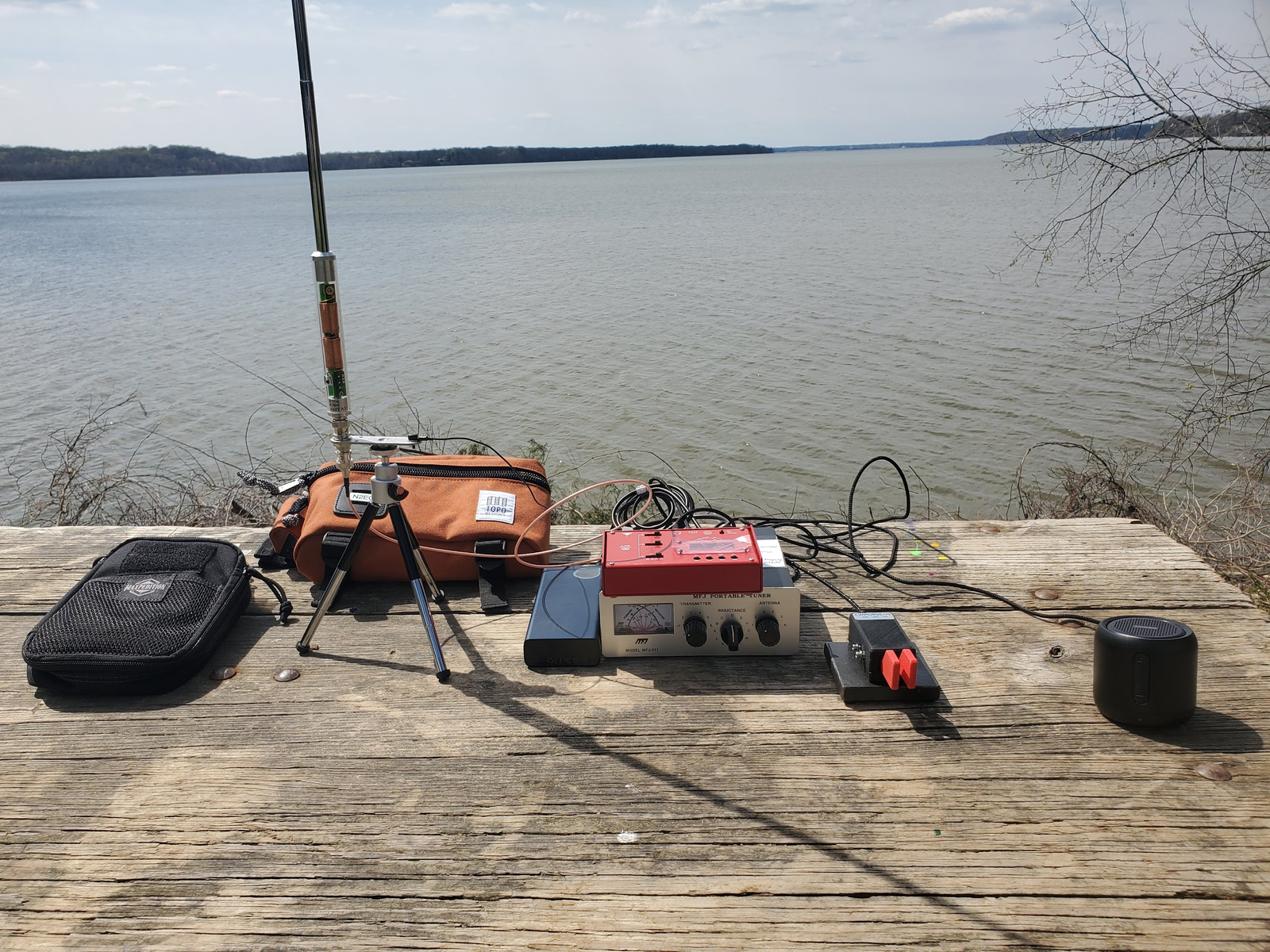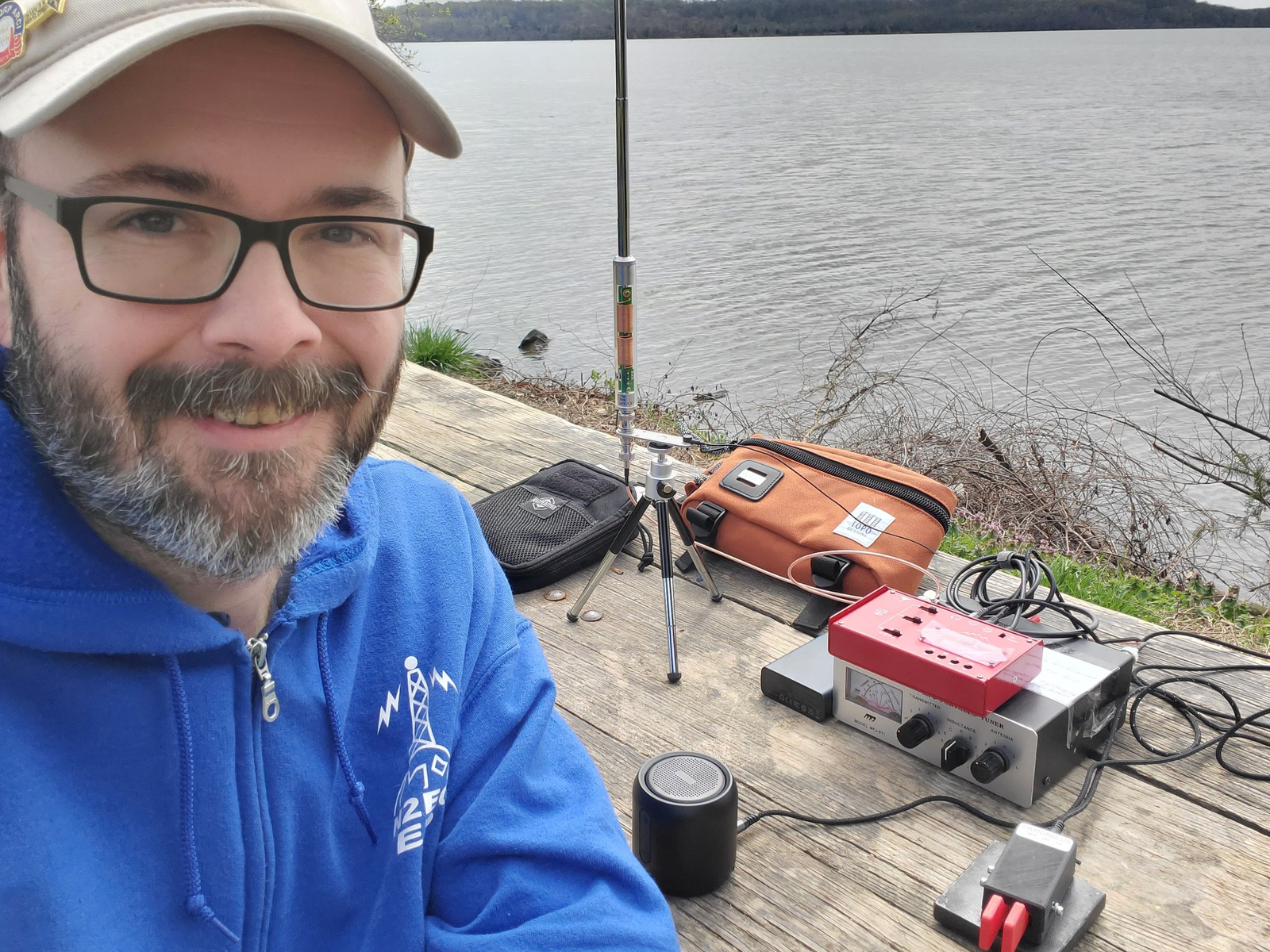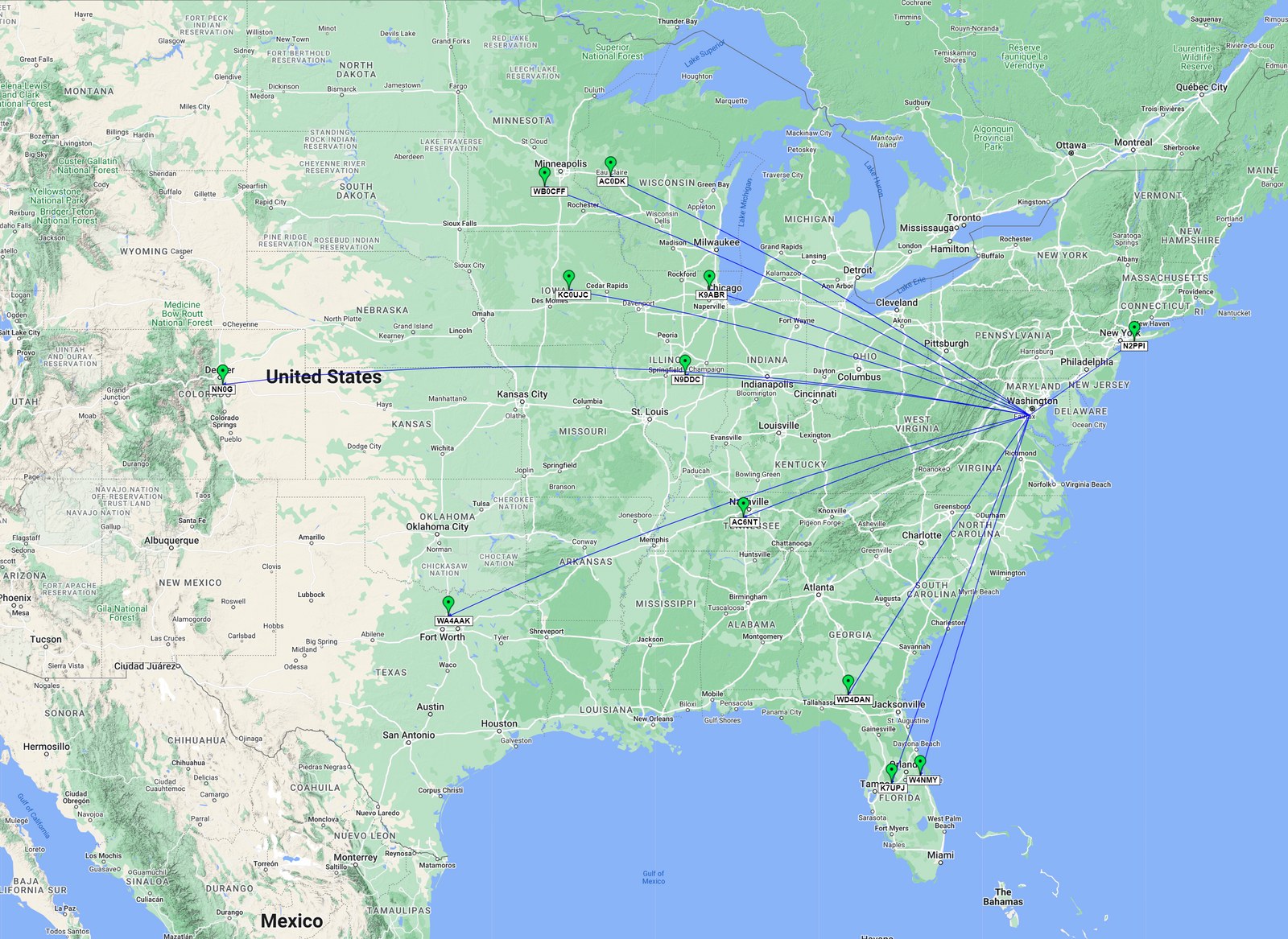POTA Activation #55: A Lunch Break QRP 4 Park Activation with a New Rig and New Antenna (VA) (3/28/2023)

I have been interested in getting a Mountain Topper radio for a while now, but they have been mostly out of stock for a long time. Supply definitely has been outstripped by heavy demand and when a new tranche of radios is released into the wild, they are usually gone in a day's time. I was looking at an online forum and saw someone mention that a set of 100 Mountain Topper MTR-4B radios had been released on the LNR Precision site, so I decided to go for it and get my order in for one of the radios. I believe I was #26 in-line and they said they hoped to ship some out immediately and others could take a month or more. As Tom Petty said, the waiting is the hardest part, but after about a month I received notification of my radio being shipped from North Carolina. It finally came in the mail on Friday, and on Saturday I was able to get it hooked up at home and run it through its paces. I tested it on all 4 bands (80m, 40m, 30m, and 20m) and was spotted with just under 5 W on all of them on the Revere Beacon Network. I even had a couple of really nice ragchews: one with a station in Binghamton, NY, and another with a station in Raleigh, NC, both on 40m, even with some challenging propagation conditions. The receive audio was astonishingly quiet with so little noise that I had to initially wonder if it was on, but the signals were very clear on receive. I was very happy.
Of course, that's not all that is necessary for an ultra-portable setup. I pulled out an MFJ-971 Portable Antenna Tuner to make sure that it was well matched with my home antenna, and it did the job quite well on all bands with a 1:1 on 80m, 40m, and 30m, and about a 1.4:1 on 20m. It is on the bigger side, but it was what I had on hand. I have a smaller QRP tuner on my kit building queue that will allow me to get everything even smaller. I also decided to run on battery power with a new power bank during my testing as well. The MTR4B really wants 12V, and no more than 13V for its supply voltage, so I looked at various options for powering it. I could use my LiFePO4 batteries with some in-line diodes to drop the voltage, but I decided to investigate an idea that I found quite intriguing. Using a USB Power Bank that supports the PD standard.
If you're not familiar with PD, it is short for Power Delivery, and it is one of the primary ways that fast charging is being implemented on USB C devices these days. Basically, there is a chip in the power supply that communicates with the load device that allows the load to request a higher voltage for a given current, allowing more power to be delivered. Regular USB uses 5V, but PD can also supply 9V, 12V, 15V, and 20V. To get the voltage you want for non-USB devices, trigger cables are created that have a chip in them to negotiate a desired voltage with the power supply and then provide that voltage as a regular DC power output. In my case, I wanted 12V, and I was able to find a trigger cable purpose-built for that voltage complete with the right dimension barrel jack with the correct polarity from Amazon from the vendor JacobsParts. It put out 12.0 V on the nose. Fantastic.
For the power supply itself, I got a 65W 20,000mAh PD USB power bank from Baseus on Amazon. This has the benefit of being able to power all my devices with ample power including my phones, tablets, laptops, and yes, my radios. For the MTR4B I'm using the 12V cable, for the others, I can use a 15V cable. The battery is below the 100 Wh threshold that garners extra scrutiny from the TSA and they see power banks all the time. For my upcoming trip to Greece, this will be an essential part of my kit. When I first hooked things up, it was with some trepidation as I worried that the boost converters on-board might introduce noise into the HF bands. Thankfully, no noise was heard, only quiet receive. Perfect. So we have power, we have a tuner, and we have a radio. How about the antenna?
For this first activation with the radio I decided to use my recently acquired Elecraft AX1 antenna for its maiden voyage. It is a multi-band whip antenna capable of being used on 20m, 17m, and 15m out of the box, and with the AXE1 loading coil, it can be tuned up on 40m and 30m as well. With that antenna and the coil, I can use 75% of the bands the rig can use. The antenna is certainly "compromised" with its small form factor, but there are a lot of POTA activators that have had success with it, so when you're the DX, it might be a great tool to have a super portable antenna that can be deployed almost anywhere. We would certainly find out.
Rounding out the kit was a new Anker Soundcore Mini speaker since the Mountain Topper doesn't have an internal speaker (or even a volume control for that matter). Unlike many modern speakers, this one has an 1/8 inch stereo jack, so I could connect the headphone out to the input of the speaker. I could also use headphones with an in-line attenuator if desired, but I knew that the park I was going to was relatively quiet and usually not busy enough on a weekday to have my beeping be a nuisance to other park visitors. I even got a kid and his mother come by and ask about the Morse code and who I was talking to, and they were stunned when I said I had just talked to someone in Colorado. But hey, I'm getting ahead of myself.

I had a window of time on my lunch hour while I was working from home, so I decided to head over to one of my favorite spots that also happens to be a 4-fer. I was able to have everything radio and CW related in the hip pack and the antenna was in the Maxpedition organizer. The tuner I carried by itself. I found an empty picnic table right on the banks of the Potomac river and started setting up the station. Everything worked perfectly, and after a few seconds switching the inductor to maximum noise, I was able to modify the transmitter capacitance to get a 1:1 match on the 20m band CW portion. I gave a heads-up to my friends in the Long Island CW Club, spotted myself on the POTA spots page, and started calling CQ on 14.042 MHz.
I'll be honest, the going was slow. My first contact was with a station in Florida, followed by about 6 minutes of no responses to my CQs. Then I heard back from a station in Tennessee that was giving me a rather optimistic 599, but hey, I'll take it. 2 in the log. Shortly thereafter I got a call from a station in Wisconsin who heard me 339, so 3. After another 4 minutes of calling CQ, I heard back from a station in Minnesota who heard me better than I heard him, so 4 in the log. After another minute I heard from a Texas station with a 559 both ways, followed by 6 minutes of unanswered CQs. Colorado was next, with a 559 both ways for the 6th entry in my log.
Shortly after that contact a woman and her son came by to inquire about the Morse code and I gave a quick explanation and told them I had communicated with someone in Colorado and they seemed very excited to hear that.
I kept calling CQ and after another 3 minutes heard back from a station in Illinois. 7 in the log. After a lot of 100W activations lately, I forgot how QRP can test your patience. But it felt good to be making my way toward the goal, so I kept calling CQ, quietly wishing I had set the memory keyer up before I started the activation with my CQ.
I would be calling CQ for quite a bit of time -- 12 minutes, before I would hear from a station in Florida who gave me a 229. Glad he stayed with me, I really needed the contacts and was starting to worry I might have to fall-back to my mobile station and 100 W to finish this thing.
I kept going and after another 2 minutes got a call back from a familiar call, Dan, WD4DAN, who was loud and clear and gave me a (likely optimistic and kind) 599 both ways from Georgia. That made 9 contacts. So close. Unfortunately, I would be on the precipice for another 12 minutes, calling out into the void. Then 47 minutes after I started, I got contact number 10 from a station in Illinois. We had some QSB between us, but on the peaks I heard him 569 and he heard me 559. The activation was made. I decided to keep going and 2 minutes later got a call from Iowa, hearing me 319, very glad he was able to pull me out of the noise. After making 11, I decided to call QRT and call it an activation.
I packed up my station and made my way back to the car and saw an alert from my LICW friend Mike, N2PPI. He was down in Florida on a vacation and had been operating and asked the group if anyone wanted to make a contact. My QRP setup was dismantled, but I turned on the mobile rig and heard him calling CQ, so I called him back and we had a quick QSO. Since I was still in the park(s) I added him to my log and headed on home.
In all I had made 12 contacts in 1:06, tested out a lot of new gear, and got to enjoy a bit of a QRP adventure. When I got home, I saw that band conditions were not great on 20m and below, so that might have explained some of the challenge I had faced. Even with the slow rate, it was a lot of fun digging out the signals from the noise to find the auditory treasures beneath.
I am pleased with how everything worked. The Mountain Topper is a wonderful rig that is a pleasure to listen to super simple to operate. The AX1 has to be the easiest antenna to deploy I own -- I look forward to giving it some more activations, hopefully on days with better band conditions. The Baseus USB PD Power Bank really impressed me with how easy it made powering everything. Even after nearly an hour on the air, I had gone from 100% to 98% on the battery pack. This thing can activate forever. The MFJ 971 did the job quite well. It is big though, so I'm looking forward to building a smaller manual tuner soon. And finally, it was a lot of fun having a setup this compact. This will be great for Greece and would be great for a long hike-in to a park or a summit. It still blows my mind that a radio in a hip pack and a skinny little whip can communicate clear across the country using a phone charger. So much fun.

Activation QSO Map: Green Pins = CW / Blue Lines = 20m (N2PPI actually near West Palm Beach, FL)
Gear used in this activation
- LNR Precision Mountain Topper MTR4B
- Elecraft AX1 Multi-Band Whip Antenna
- MFJ-971 Portable Tuner
- CW Morse Pocket Double Paddle Morse Code Key with Magnets
- CW Morse Steel Base for Pocket Paddles
- Baseus Power Bank (65W, 20,000 mAh, PD3.0)
- JacobsParts 12V/5A USB C PD Trigger Cable
- Anker Soundcore Mini Portable Speaker
- Topo Designs Hip Pack
- Maxpedition Fatty Pocket Organizer
- Amazon Basics Lightweight Mini Tripod
- Samsung Galaxy S10+
- HAMRS Logging App

